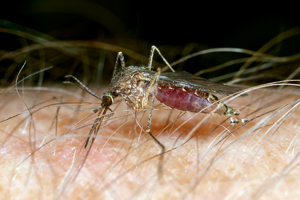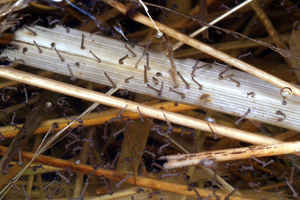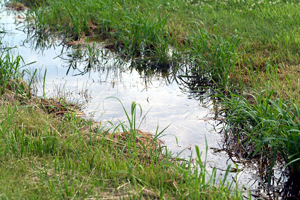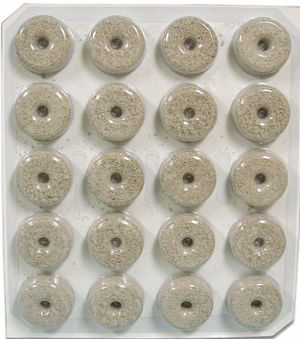G2037
Residential Mosquito Control
This NebGuide discusses the life cycle, control, and impact of mosquitoes common to Nebraska.
Barbara P. Ogg, Extension Educator
Frederick P. Baxendale, Extension Entomologist
James A. Kalisch, Extension Associate
|
There are an estimated 150 mosquito species in North America and 50 species in Nebraska. Mosquitoes (Figure 1) belong to the order Diptera, which also includes flies, gnats, and midges. Mosquito larvae require a moist or wet environment to develop. They breed in wetlands, stagnant pools of water, tree holes, and a variety of other artificial receptacles that retain water. Mosquitoes are vectors — insects that transmit pathogens — of many debilitating human diseases, including malaria, yellow fever, dengue, and West Nile virus.
Biology and Identification
Mosquito species that share similar characteristics are separated by scientists into larger groups called genera, or genus as a singular name. Examples include Aedes (Ae.), Anopheles, Culex (Cx.), Culiseta, and Ochlerotatus (Och.). The most numerous mosquito species in Nebraska are Ae. vexans, Cx. tarsalis, Culiseta inornata, Och. trivittatus, Och. dorsalis, Och. triseriatus, and Och. melanimon.
Aedes mosquitoes are daytime biters, which breed in floodwaters. Culex mosquitoes are evening/dusk feeders. They breed in both floodwaters and permanent bodies of water.
Mosquitoes pass through four distinct stages — egg, larva, pupa, and adult (Figure 2).
 |
| Figure 2. (a) Mosquito eggs may be laid singly or in a raft, depending on the species. Culex tarsalis eggs are laid in a raft formation in water; (b) larva (wriggler) stage; (c) pupa (tumbler) stage; (d) adult mosquito. |
|
Mosquito eggs may be laid singly or in a raft, depending on the species. Eggs may be laid on soil or vegetation or in tree holes, but most mosquito species deposit their eggs singly or in rafts in or near water. All eggs must be in water to hatch, as larvae and pupae live in water. However, eggs from some floodwater mosquitoes can remain dormant and viable for one to three years even without water.
Mosquito larvae, also called “wrigglers” (Figure 3), survive best in still water, where they can come to the surface and breathe through a breathing tube. Most mosquito larvae feed on suspended plant material and organic particles in the water. In warm conditions, the larval stages develop in about five to seven days before transforming into the pupal, or “tumbler”, stage. True to their name, tumblers are highly active as they sink and rise to the surface. They do not feed.
After two to three days, the adult mosquito emerges from its floating pupal skin. Mosquitoes are good fliers and can disperse several miles from where they emerge. While male mosquitoes feed on nectar, fertilized females seek a blood meal, which is needed for maximum egg maturation. A single female may deposit hundreds of eggs and take several blood meals during her lifetime.
Most mosquito species feed on either warm- or cold-blooded animals, with birds often being an important host. Birds also may be a reservoir for some of the encephalitis and avian malarial disease agents and West Nile virus. Mosquitoes probably live about two weeks. In Nebraska, some species can produce several generations per year, while others may have only one.
Mosquito-Transmitted Diseases
Culex tarsalis is probably the most important vector of mosquito-transmitted diseases in Nebraska. The Asian tiger mosquito, Ae. albopictus, also is an efficient disease vector and has been found in Nebraska, but its level of establishment and status remain unclear.
Epidemiologists classify Cx. tarsalis as a very efficient vector and Ae. vexans as a moderately efficient vector of West Nile virus. Ae. vexans probably serves as a bridge between birds and mammals in the virus transmission cycle.
West Nile Virus (WNV). WNV is currently the most important mosquito-vectored disease in the U.S. It first appeared in the U.S. in 1999, and by 2003, had spread across the continental United States. It is believed that 80 percent of human WNV cases show no disease symptoms, and as a result, are never reported to the Centers for Disease Control (CDC). Victims of WNV can occasionally develop encephalitis or meningitis, which can be serious or lethal. From 2001 to 2009, more than 1,100 deaths in the U.S. were attributed to WNV. Most of these deaths involved people older than 65 years, and to a lesser degree, people with underlying health problems.
Culex tarsalis is probably the most capable vector of WNV throughout Nebraska and the western U.S. West Nile virus primarily follows a bird-mosquito cycle beginning when birds are nesting in the spring and continuing into early summer. By late June the mosquitoes shift their host range to include humans and other animals, including horses. Vaccines are available for West Nile virus and encephalitis strains for horses, but not for humans. The West Nile equine vaccine, administered by veterinarians, requires two injections about two weeks apart to be effective, and then an annual booster. This vaccine is estimated to be 90-95 percent effective; the other encephalitis vaccines are somewhat less effective. More information about protecting horses from WNV can be found in the UNL NebGuide, West Nile Virus Guidelines for Horse Owners at http://www.ianrpubs.unl.edu/sendIt/g1877.pdf.
Dog Heartworm. The microfilarial worms of dog heartworm, Dirofilaria immitis, are ingested by mosquitoes during feeding on an infected animal. They later develop to the infective stage within the mosquito and are eventually transmitted to healthy dogs (and sometimes cats) during later feeding. Once inside the dog’s body, the worms develop into full-sized adults and lodge in the dog’s heart. Adult female worms, which may reach a length of 12 inches, cluster in the heart, causing shortness of breath, coughing, jaundice, convulsions, exhaustion, and possibly death.
Note: Dogs exposed to mosquitoes should first be tested by a veterinarian. Animals that have already contracted the worms must be treated under close veterinary supervision. Noninfected dogs should be put on a heartworm preventive program before the mosquito season begins. All pharmaceutical remedies should be obtained from a licensed veterinarian after examination and testing of the pet.
Mosquito Management
|
Home Environment and Landscape
The most important element in mosquito control is the removal of standing water. It is important to identify all the sites mosquitoes can breed in residential environments.
Eliminate Breeding Sites. Mosquito breeding sites in urban and residential areas include children’s wading pools, rain barrels, birdbaths, flower pot bases, clogged gutters, pails, and discarded tin cans — anything that can trap and hold water. Additional sites for acreages and country settings (Figure 4) include ponds, ditches, sewage lagoons, and used tires. Because mosquitoes breed quickly in the summertime, standing water should be drained weekly. Rinse and clean birdbaths on a weekly basis and cover wading pools.
Keep Your Home Mosquito-Free. Check doors, windows, and window screens to ensure they are in good repair. Screens should be 16 mesh per inch or finer. Reduce outdoor lighting to minimize attraction of adult mosquitoes. Keeping porch lights off when not needed and replacing traditional white light bulbs with yellow ones is helpful.
Reduce Mosquito Resting Sites. Keep lawns mowed and ornamental plantings well-manicured, especially in areas adjacent to dwellings, to reduce mosquito staging areas.
Personal Protection
Protect Yourself When Working Outdoors. Wear long-sleeved shirts and full-length trousers. Two layers of clothing are more difficult to penetrate by biting mosquitoes. If you spend a lot of time outdoors, buy a mosquito net at a sporting goods store and wear it over your hat. Work outdoors when mosquitoes are less active or when there is brisk air movement or strong sunlight. If possible, time outdoor activities to avoid the predominant mosquitoes in your area. For example, Culex mosquitoes are generally most active in the early evening hours.
Use Personal Repellents. The CDC recommends four active ingredients registered by the Environmental Protection Agency for repelling mosquitoes. These active ingredients have been reviewed during the registration process and have been approved for effectiveness and human safety when applied according to label instructions.
Many factors play a role in a repellent’s effectiveness, including:
- Product concentration. Repellents containing concentrations of greater than 30 percent active ingredient do little to increase the level of mosquito repellency.
- Frequency and uniformity of application. Better results are achieved if a repellent is more frequently and thoroughly applied, but be sure not to exceed label directions.
- Activity level of the user. Effectiveness of a repellent is reduced by evaporation and absorption from the skin surface and by being washed off by sweat.
- Environmental conditions. Rain showers wash the repellent off the body or clothing, and wind and high temperatures reduce a product’s effectiveness.
- Human attractiveness to blood-feeding arthropods. Unfortunately, some people are more attractive to mosquitoes than others, and they will need to be more diligent in applying repellent.
- Number and species of blood-feeding arthropods. The higher the number of hungry mosquitoes, the greater the possibility of being bitten, regardless of repellent use.
The EPA characterizes the active ingredients DEET and picaridin as conventional repellents. Two other active ingredients, oil of lemon eucalyptus (PMD) and IR3535, are characterized as biopesticides, being derived from natural, organic substances.
DEET (Chemical name: N,N-diethyl-m-toluamide). The gold standard for insect repellents is still DEET, a chemical developed in the 1940s for the U.S. Army. Depending on conditions during use and concentration, DEET provides two to eight hours of protection. It has broad activity and is effective against mosquitoes, midges, chiggers, fleas, and ticks. Common products containing DEET include Ben’s™, Off™, Repel™, and many more.
Millions of people have used DEET since it became available to the general public in 1957. It is considered safe when used according to label instructions.
For casual use, a product containing 10-30 percent DEET should be adequate. For children, it is best to keep the concentration of DEET at 10 percent or less. In special cases, as with skin sensitivity, it may make sense to only spray clothing.
DEET repellents can damage plastics, leather, and synthetic fabrics, so care must be taken when applying the repellent to some types of clothing.
Picaridin (KBR 3023). (Chemical name: 2-(2-hydrozyethyl-1-piperidincarboxylic acid 1-methylpropyl ester). Picaridin provides two to eight hours of effective repellency, and has comparable efficacy to DEET products of the same concentration. Because it is odorless, not irritating or greasy, and doesn’t damage plastics or synthetic materials, many people prefer picaridin to DEET.
Picaridin-based repellents, which have been available outside the U.S. for many years, were introduced in the U.S. in 2005. Some products containing picaridin include Cutter Advanced™ Insect Repellent (7 percent), Cutter Advanced Sport™ (15 percent), Avon Skin-So-Soft™ Bug Guard Plus Picaridin (10 percent), Natrapel™ 8 hour Insect Repellent (20 percent), Off Family Care Insect Repellent™ (10 percent), and Walgreens Light and Clean Insect Repellent™ (7 percent). In addition to repelling mosquitoes, picaridin was tested in laboratory and field studies and found to be effective against biting flies and ticks.
Oil of Lemon Eucalyptus or PMD (Chemical name: para-methane-3,8-diol). The active ingredient PMD was isolated from the oil of the lemon eucalyptus plant. It was introduced in the U.S. in 2002. A 40 percent formulation appears to provide about six hours of protection. PMD-based repellents show low human toxicity, but can be eye irritants. Note: “Pure” oil of lemon eucalyptus formulations have not been tested for safety and efficacy.
Marketed products containing oil of lemon eucalyptus include Repel Lemon Eucalyptus Insect Repellent Lotion™ (30 percent), Repel Plant Based Lemon Eucalyptus Insect Repellent™ (40 percent), Cutter Lemon Eucalyptus Insect Repellent™ (30 percent), and Off Botanicals Insect Repellent™ (10 percent).
IR3535 (Chemical name: 3-[N-Butyl-N-acetyl]-aminopropionic acid, ethyl ester). IR3535 is labeled for use against mosquitoes, ticks, and biting flies. In some studies, IR3535 provided protection for four to six hours, but another USDA study found that 25 percent IR3535 was 10-100 times less effective than DEET. Some products include Skin-So-Soft™ Bug Guard Plus IR3535 Active Insect Repellent (7.5 percent), Skin-So-Soft™ Bug Guard Plus IR3535, Expedition Insect Repellent (15-20 percent), and DEET Free Coleman Skin Smart Insect Repellent™ (20 percent).
What about Skin-So-Soft™ bath oil? Made by Avon, this oil has been shown in laboratory tests to have minimal repellent effect. It is at least 10 times less effective than 12.5 percent DEET. Avon has never marketed the bath oil as an insect repellent.
Mechanical and Electronic Devices
Mosquito Traps. Recently, a number of mosquito traps have become available to consumers for attracting and trapping mosquitoes. They use propane to generate carbon dioxide and employ attractants such as octenol to draw and capture mosquitoes. Some models add flickering blue lights as lures and have vacuums to suck up their victims. Generally, these devices are costly to purchase and maintain for the benefit received. They work best as peripheral devices to draw mosquitoes away from areas designated for human activities. Reviews from consumers are quite mixed. While such devices may perform well, they may not be sufficient to provide relief in cases where mosquito numbers are high. Examples of mosquito traps are Koolatron™ Mosquito Trap™, Lentek Mosquito Trap™, Mega-Catch™, Mosquito Magnet™, and SkeeterVac™.
Bug Zappers. Electrocuting devices, popularly known as “bug zappers”, are not very effective at controlling mosquitoes. They are not selective for mosquitoes and kill beneficial insects as well. Mosquitoes make up less than 1 percent of the insects killed by these devices.
Ultrasonic Devices. High frequency ultrasonic devices are advertised to effectively repel mosquitoes. But, studies show they do not deter female mosquitoes from attempting to bite, nor do they cause mosquitoes to flee from the sound.
Mosquito-Repellent Plants
Citrosa geranium (“mosquito plant”), citronella grass, and lemon thyme are often advertised as mosquito-repellent plants useful for repelling mosquitoes in patios or garden settings. These plants in and of themselves display no repellency, but rather the crushed leaves or refined extracts from these plants do, in fact, display repellency comparable to low-percentage DEET formulations. Compounds from these and other plants have been formulated into products available as natural alternatives to chemical repellents.
Insecticidal Control
Pre-Treat Before Outdoor Parties. Control resting adult mosquitoes on lawns, flower borders, smaller trees, and shrubs with a labeled insecticide about three hours before the planned event. Always check the label to verify site uses to avoid possible plant sensitivity issues. Consider burning citronella candles or citronella oil in lanterns during your activity. Remember that barbecue smoke itself will repel some mosquitoes. If you don’t want to spray, consider providing your guests with a repellent, or hold your event indoors.
|
Adult Control. Adult mosquitoes can be controlled outside the home by spraying turf and surrounding landscape plants with a labeled insecticide. Unfortunately, these treatments normally last only a few days, but they are quite helpful when applied a few hours before outdoor gatherings. Appropriate insecticides include bifenthrin, permethrin, lambda-cyhalothrin, and cyfluthrin.
For temporary relief from flying mosquitoes in an outdoor area, aerosol foggers and fogging devices containing pyrethrins, esfenvalerate, and permethrin are helpful for immediate knock-down of adults.
Indoors, aerosol space sprays containing pyrethrins and piperonyl butoxide will effectively control mosquitoes in the home, garage, and/or animal containments.
Larval Control. The bacterial agent, Bacillus thuringiensis israelensis (Bti), is specific to mosquito larvae and certain other semi-aquatic flies, but is safe for birds, fish, mammals, and other organisms. Birds can safely drink water from bird baths treated with Bti. These microbial insecticides (Aquabac™, Teknar ™, Bactimos™ , Vectobac™) are typically available as briquets or granules (Figure 5).
The insect growth regulator, methoprene, is also available in briquette or granular form. It kills mosquito larvae by interfering with their development but has no effect on pupae (tumblers) or adults.
These products are available in hardware stores, garden centers, and farm supply and home improvement stores. Once wetted, the active ingredients are gradually released from the formulated product and may be effective for 30 days.
A formulation of Bacillus sphaericus (Vectolex CG™) can be used in water with high levels of organic matter such as stagnant sewage lagoons.
Take Precaution with Chemicals. Be sure to read and follow product labels for specific instructions, application sites, restrictions, and warnings. Choose a product based on cost, effectiveness, environmental safety, and label restrictions. Applications to control adult mosquitoes should not include open water, but should include temporary shallow water with dense vegetation, trees, and shrubbery where adult mosquitoes rest during the day.
Disclaimer Reference to commercial products or trade names is made with the understanding that no discrimination is intended of those not mentioned and no endorsement by University of Nebraska–Lincoln Extension is implied for those mentioned. |
This publication has been peer reviewed.
Visit the University of Nebraska–Lincoln Extension Publications Web site for more publications.
Index: Insects & Pests
Other Pests
Issued September 2010



